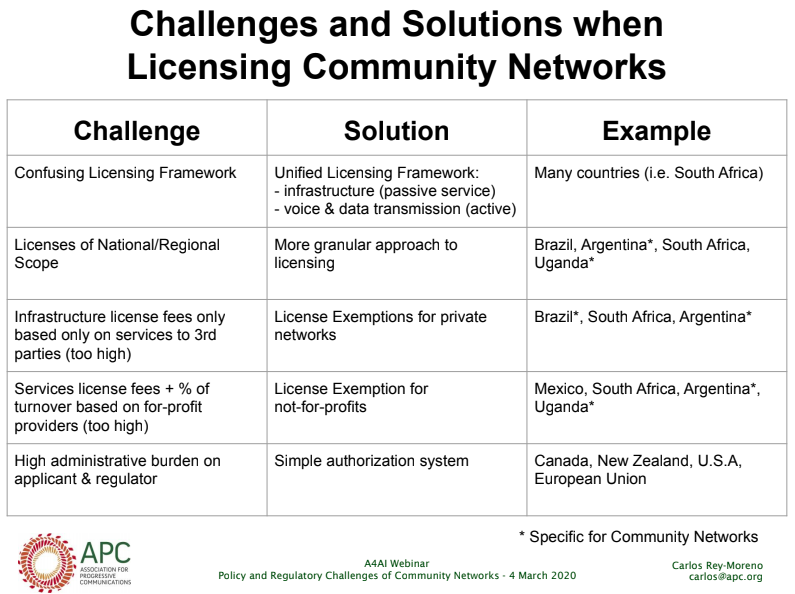
This post was written by A4AI Deputy Director and Policy Lead Eleanor Sarpong.
In times of crisis, access to the internet is a lifeline — connecting us to loved ones, to our work and education, and to health information. But today, in the midst of the coronavirus pandemic, over 3 billion people across the globe are offline, cut off from vital resources.
Community networks — networks built, owned and operated by and for local communities — show great promise to connect the unconnected around the world as one component of healthy broadband markets. Community networks deliver access to underserved areas — oftentimes locations that are financially unattractive for mainstream internet service providers — and lower connectivity costs for communities. Today, there are many community networks providing affordable services to unserved communities in places like Myanmar, India, South Africa, Brazil, Spain and the United States.
To connect those who traditional networks are not properly serving and help bridge the growing digital divide, policymakers must prioritise the policies and regulations that allow these networks to expand their reach.
We continue to advocate for innovative policy and regulation that empowers the development and design of community networks. For example, our newly launched Rural Broadband Policy Framework highlights the importance of alternative and complementary solutions to traditional internet service providers to boost affordable and meaningful connectivity.
As part of our efforts to increase the visibility and impact of community networks as access solutions, we recently brought together partners and leading experts to discuss how policymakers can support these networks. The webinar illustrated six key lessons.
- Community networks need open access to reliable and affordable high speed backhaul networks. Steve Song, a key advocate of community networks, said policymakers must ensure community networks have open access to reliable and affordable high speed backhaul networks as well as open internet exchange points at non-prohibitive rates. This can be mandated by legislation or encouraged by policy. Brazil and Nigeria both included these requirements in their recent broadband plans and strategies.
- Affordable spectrum is essential to operate community networks. Although spectrum allocations vary from region to region, all regulations should be agile and forward-looking to embrace growth.
- Clear licensing requirements can encourage the growth of community networks. Reducing the high administrative burden on community networks through simple authorisation systems has been proven to work in New Zealand and parts of the European Union.
- Reduced fees and tax benefitscan help networks expand by lowering operating costs and encouraging investment. Carlos Rey-Moreno from the Association of Progressive Communications cited examples of reduced license fees and tax exemptions that helped community networks in Brazil, South Africa and Mexico expand. To encourage investment in community networks, regulators in countries such as Spain, Canada and the UK considered allowing tax deductions for contributions to cooperatives and not-for-profits. Other funding examples include the use of universal service funds in India and innovation funds in South Africa, as shown in Table 1.
- Partnerships are essential. Based on her first-hand experience as the co-founder of TunapandaNET in Kenya, Josephine Miliza offered the following advice to community network providers: “Partnership and engagement within the ICT ecosystem is key.” This cooperation can include shared resources among community networks, clear parameters for mobile telecoms providers and community networks, and policies developed with input from all stakeholders.
- Community networks need local champions, backed by political will and in partnership with policymakers, to be successful. As more countries recognise the importance of community networks, we expect to see relevant legislation at national and local levels. Jane Coffin of Internet Society highlighted model legislation from Mexico to Zimbabwe.
Community networks, supported by bold and dynamic policy and regulation, hold immense potential to close the digital divide.
Want to learn more about community networks and the policy actions needed to support their growth?
- Watch the full webinar here.
- View the webinar slides.
- Read the community networks edition of the Web Foundation’s The Web Untangled newsletter.
- Explore our Good Practices Database for lessons from successful case studies around the world. We invite our members and partners to suggest cases to include in this shared resource.
For more updates on our work, follow us on Twitter at @a4a_internet.
One Response


In Tanzania Community Networks are not just for accessible and affordable. They are the Digital Hubs of Everything. For example hosting of E-Adult Education is one of the services that will bring adult education at people’s doorstep,especially in rural,remote and undeserved peri-urban centers. So Community Network is more than just having a telecommunication infrastructure for connectivity and affordable Internet access. It is a change-maker in rural innovation and a promise to deliver Internet/Digital Literacy and piece of the digital economy pie in the remotest places!